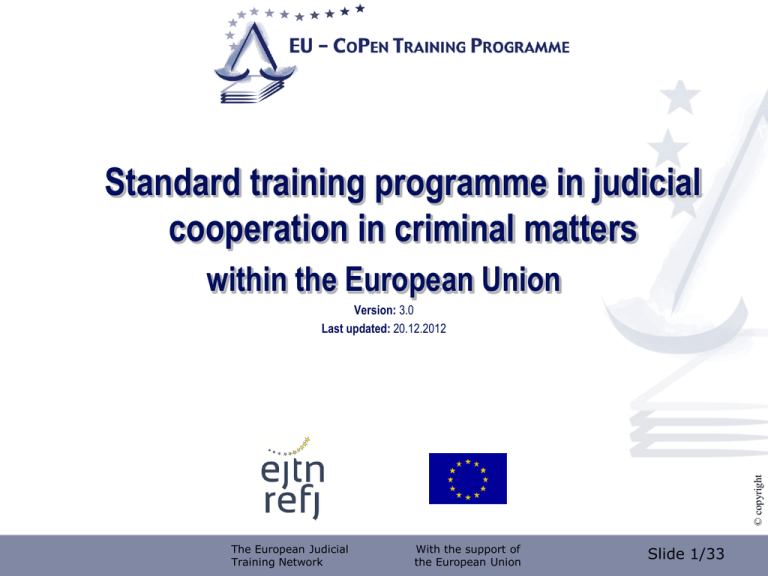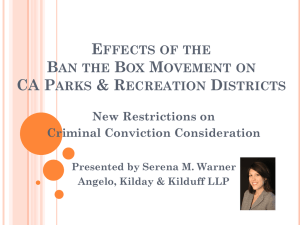General Introduction
advertisement

Standard training programme in judicial cooperation in criminal matters within the European Union © copyright Version: 3.0 Last updated: 20.12.2012 The European Judicial Training Network With the support of the European Union Slide 1/33 (logo of the training organiser) Training organised by (name of training organiser) on (date) at (place) © copyright Title (of the training/ module) The European Judicial Training Network With the support of the European Union Slide 2/33 © copyright Module 1 General introduction: judicial cooperation in criminal matters in the European area of freedom, security and justice. Version: 3.0 Last updated: 20.12.2012 Slide 3/33 Contents Introduction: 3 general preliminary comments 2. History and institutional framework The starting point: the silence of the Treaty of Rome The launch of judicial cooperation within the EU The Maastricht Treaty The Treaty of Amsterdam and the Treaty of Nice The Lisbon Treaty and the current system 3. The European criminal law-enforcement area and its components 4. A European criminal law-enforcement area founded on national criminal procedure and criminal law © copyright 1. > Module 1: General introduction Slide 4/33 General preliminary comments 1. Diversity of geographical settings (global, regional, subregional) 2. Being part of a wider ‘Justice and Home Affairs’ field, and part of the overall objective of the EU ‘area of freedom, security and justice’ or ‘AFSJ’ 3. The extremely sensitive nature of criminal matters: • close connection with the nation-state and national sovereignty • complex relationship between criminal matters and fundamental rights: the sword/shield function of criminal law > Module 1: General introduction: Slide 5/33 © copyright 1. Introduction 2. History 2.1. The starting point © copyright Silence of the Treaty of Rome on criminal matters => Consequences regarding the competence of the European Community in criminal matters (Commission v Council cases 9/09/05 and 23/10/07) > Module 1: General introduction: History Slide 6/33 2. History 2.2. The launch of cooperation in criminal matters within the EU The 1970s: combating European terrorism The 1980s: compensatory measures accompanying the abolition of checks at internal borders Schengen cooperation (laboratory of the EU) © copyright => Cooperation outside the EC institutional framework of a purely intergovernmental nature (unanimity, democratic deficit and jurisdictional deficit) > Module 1: General introduction: History Slide 7/33 2. History • Unanimity and type of instruments • EU institutions: European Commission, European Parliament, Court of Justice > Module 1: General introduction: History Slide 8/33 © copyright 2.3. The Maastricht Treaty The Treaty on European Union and the three pillars The third pillar, or Title VI of the Treaty on European Union Absorption of cooperation into the framework of the EU (except Schengen cooperation) No major changes of objective Institutional changes: predominantly intergovernmental cooperation with shades of the Community method Characteristics: © copyright 2. History > Module 1: General introduction: History Slide 9/33 2. History 2.4. The Treaty of Amsterdam and the Treaty of Nice 2.4.1. The Treaty of Amsterdam 2.4.1.1. New objective: establishment of an area of freedom, security and justice • • Concepts of area Concepts of freedom, security and justice 2.4.1.2. Splitting of JHA matters • © copyright • Transfer to the 1st pillar (Title IV of the TEU) of asylum, immigration, border crossings and judicial cooperation in civil matters Police and judicial cooperation in criminal matters kept in the 3rd pillar > Module 1: General introduction: History Slide 10/33 2. History 2.4.1.3. Updating the 3rd pillar Maintaining the intergovernmental rationale (unanimity, predominant role © copyright of the Council, limited powers of the EP) But strengthening the role of the European Commission and Court of Justice And strengthening the effectiveness of the legal instruments available > Module 1: General introduction: History Slide 11/33 2. History Legal instruments • Non-binding: recommendations and conclusions • Binding: framework decisions, judgments (with no direct effect, but cf. Court of Justice v Maria Pupino case) and conventions • External dimension: common positions and agreements (Articles 24 and 38 TEU) > Module 1: General introduction: History Slide 12/33 © copyright Decision-making procedure • Right of initiative (Commission – Member States) • Unanimity, save for measures implementing judgments and applying conventions • Consulting the European Parliament • Negotiations within the Council 2. History The competence of the CJEU: Article 35 TEU, but conditions and limitations • Reference for a preliminary ruling but optional competence with variable geometry ( Article 35 § 1-4 TEU) • Other competences – On the legality of framework decisions and judgments on lack of competence, infringement of the Treaty, misuse of power (Article 35 § 6) – On certain disputes between Member States and certain disputes between Member States and the Commission (Article 35 § 7) © copyright • Not competent to review the validity or proportionality of operations carried out by the police or other law enforcement services in a Member State or to rule on the exercise of responsibilities incumbent on Member States to maintain law and order and safeguard internal security (Article 35 § 5) > Module 1: General introduction: History Slide 13/33 2. History 2.4.1.4. Integration of Schengen cooperation • Why? – Common objectives – Ripple effect – Prospect of enlargement – Application of flexibility: the case of the UK and Ireland – The definition of the acquis and its breakdown – The case of certain third countries associated with the Schengen convention (Norway, Iceland, Switzerland, Liechtenstein) > Module 1: General introduction: History Slide 14/33 © copyright • How? 2. History 2.4.2. The Treaty of Nice No major changes, but: • • Establishment of Eurojust Changes to the terms of enhanced cooperation 2.4.3. Conclusions of Tampere (1999) and The Hague Programme (2004) Conclusions of Tampere: • establishes the mutual recognition principle, among others The Hague Programme and Action Plan: deepens the concept of area: principle of mutual recognition (judicial) and principle of availability (police) © copyright • > Module 1: General introduction: History Slide 15/33 2. History 2.5. The Lisbon Treaty and the current system 5th stage marked: o by the Lisbon Treaty, which came into force on 1st December 2009 Radical institutional changes (see below) Important substantive changes o by the Stockholm Programme adopted by the European © copyright Council on 10 and 11 December 2012 > Module 1: General introduction: History Slide 16/33 2. History 2.5.1. Main institutional changes © copyright 2.5.1.1. Abolition of the 3rd pillar, the end of intergovernmentality and the communitisation of criminal matters. 2.5.1.2. Maintaining qualifications to the Community method 2.5.1.3. Description of the decision-making procedure > Module 1: General introduction: History Slide 17/33 2. History 2.5.1.1. Abolition of the 3rd pillar, the end of intergovernmentality and the communitisation of criminal matters. Fundamental reforms: abolition of the 3rd pillar and © copyright integration of cooperation in criminal matters into Title V of Part III of the TFEU End of intergovernmentality and communitisation of criminal matters > Module 1: General introduction: History Slide 18/33 2. History => Various consequences © copyright Transition to the ordinary legislative procedure => Codecision => Qualified majority for voting within the Council and the role of co-legislator for the EP Availability of conventional Community instruments (such as directives and regulations) > Module 1: General introduction: History Slide 19/33 2. History © copyright Strengthening of judicial review in the European criminal lawenforcement area: External review: prospect of the EU’s accession to the ECHR (Article 6 § 2 TEU) ‘Full’ review by the CJEU => competence for preliminary rulings in common law, action for annulment, bankruptcy, insolvency, damages Application of the general principles of Community law to cooperation in criminal matters (e.g. principle of primacy, exclusion of reciprocity) > Module 1: General introduction: History Slide 20/33 2. History 2.5.1.2. Some qualifications to communitisation © copyright Right of initiative: shared between the European Commission and Member States (minimum of 7 Member States) Exceptions to the ordinary legislative procedure Exception to the competence of the CJEU: still not competent to review the validity or proportionality of operations carried out by police or other law enforcement services in a Member State, or to rule on the exercise of responsibilities incumbent upon Member States to maintain law and order and safeguard internal security (Article 276 TFEU) > Module 1: General introduction: History Slide 21/33 2. History 2.5.1.3. Description of the current decision-making procedure Right of initiative (by the Commission or min. 7 MS) Involvement of the national parliaments Negotiations ending © copyright – After first reading – After second reading – Or under the terms of the conciliation proceedings > Module 1: General introduction: History Slide 22/33 2. History 2.5.2. The price to pay: the variable geometry of the European criminal law-enforcement area © copyright 2.5.2.1. Opt-outs granted to Denmark, the United Kingdom and Ireland by the Treaty of Lisbon 2.5.2.2. The complexity associated with Schengen cooperation 2.5.2.3. The general opt-out possibility granted to the UK by Protocol No 36 on transitional provisions > Module 1: General introduction: History Slide 23/33 3. The European criminal law-enforcement area and its components © copyright 3.1. Deepening/relaxation of mechanisms of cooperation in criminal matters 3.2. Establishment of European stakeholders 3.3. Approximation of laws 3.4. External dimension > Module 1: General introduction: The components of the European criminal lawenforcement area Slide 24/33 3. The European criminal law-enforcement area and its components © copyright 3.1. Deepening/relaxation of mechanisms of cooperation in criminal matters Judicial cooperation Police cooperation 3.2. Establishment of European stakeholders Main stakeholders of cooperation = police and judicial authorities of the Member States. BUT establishment of European stakeholders to facilitate cooperation: Eurojust, EJN, Liaison magistrates/Europol > Module 1: General introduction: The components of the European criminal lawenforcement area Slide 25/33 3. The components of the European criminal lawenforcement area 3.3. Approximation of laws 3.3.1. Substantive criminal law Main instruments adopted since the entry into force of the Maastricht Treaty. Conventions adopted under the 3rd pillar of the Maastricht Treaty © copyright (e.g. Convention on the protection of the EC’s financial interests (1995), Convention against corruption involving officials (1997)) A number of joint actions adopted under the 3rd pillar of the Maastricht Treaty (e.g. Joint Action concerning action to combat racism and xenophobia (1996), Joint Action on making it a criminal offence to participate in a criminal organisation (1998)) > Module 1: General introduction: The components of the European criminal lawenforcement area Slide 26/33 3. The European criminal law-enforcement area and its components or Nice Treaty (e.g. FD protecting the euro against counterfeiting (2000), FD on combating fraud and counterfeiting of non-cash means of payment (2001), FD on money laundering, the identification, tracing, freezing, seizing and confiscation of instrumentalities and the proceeds of crime (2001), FDs on terrorism (2002 and 2008), FD combating human trafficking (2002), FD on facilitation of unauthorised entry, transit and residence (2002), FD on combating corruption in the private sector (2003), FD on the sexual exploitation of children and child pornography (2003), FD on criminal acts and penalties in the field of illicit drug trafficking (2004), FD on attacks against information systems (2005), FD on the fight against organised crime (2008), FD on combating certain forms and expressions of racism and xenophobia by means of criminal law (2008)...) > Module 1: General introduction: The components of the European criminal lawenforcement area Slide 27/33 © copyright FDs adopted under the 3rd pillar, as amended by the Amsterdam Treaty 3. The European criminal law-enforcement area and its components Directives adopted • before the entry into force of the Lisbon Treaty (e.g. Directive on the protection of the environment through criminal law (2008), Directive on ship-source pollution (2009) and Directive providing for sanctions against employers of illegally staying third-country nationals (2009). • after the entry into force of the Lisbon Treaty (e.g. Directive on preventing and combating trafficking in human beings and protecting its victims (2011), and the Directive on combating the sexual abuse and sexual exploitation of children and child pornography (2011) © copyright More or less identical structure of these instruments Limitations of the approximation achieved... > Module 1: General introduction: The components of the European criminal lawenforcement area Slide 28/33 3. The European criminal law-enforcement area and its components Before the entry into force of the Lisbon Treaty, few instruments were adopted: FD on the standing of victims (2001) FD on confiscation of crime-related proceeds, instrumentalities and property (2005) + Failure of other proposals, including proposed FD on procedural safeguards Since the entry into force of the Lisbon Treaty, initiatives have increased Directive on the rights of victims (2012) Directive on the right to interpretation and translation (2011) Letter of Rights Directive (2011) ... > Module 1: General introduction: The components of the European criminal lawenforcement area Slide 29/33 © copyright 3.3.2. Procedural criminal law 3. The European criminal law-enforcement area and its components The external dimension has developed since the entry into force of the Amsterdam Treaty (cf. specific provisions to this effect: Arts 37 and 38 TEU) Political instruments: declarations, action plans, programmes Legal instruments Common positions Agreements concluded before the entry into force of the Lisbon Treaty (Article 24 and 38 TEU) Agreements concluded since the entry into force of the Lisbon Treaty (Article 216 et seq. TFEU) Agreements adopted by EU agencies (e.g. agreements concluded by Europol and Eurojust) > Module 1: General introduction: components of the European criminal law-enforcement area Slide 30/33 © copyright 3.4. External dimension development 4. A European criminal law-enforcement area founded on national laws 4.1. Similarities Common values Membership of the Council of Europe, ECHR, Eur. Court HR case-law 4.2. Differences Substantive criminal law Offences Penalties Procedural criminal law © copyright > Module 1: General introduction: founded on national laws Slide 31/33 4. A European criminal law-enforcement area founded on national laws Examples of differences in substantive criminal law Offences • Classifications • Principle of criminalisation • Definitions of criminal offences (cf. differing interpretations of certain fundamental freedoms) • Rules on participation and attempted offences • … Penalties Types of penalties New sentences Systems applied to common traditional sentences … > Module 1: General introduction: founded on national laws © copyright • • • • Slide 32/33 Examples of differences in criminal procedure Conventional opposition • Adversarial systems (Common Law) • Continental procedure or inquisitorial systems Distribution of powers between the investigative and prosecution © copyright functions Determining the authority responsible for the investigations (balance of powers between police/public prosecutor + investigating judge) The contents and opinions expressed herein are solely that of the EJTN, and the European Commission cannot be held responsible for any use that may be made of these contents and 4. A European criminal law-enforcement area founded on national laws > Module 1: General introduction: founded on national laws Slide 33/33









